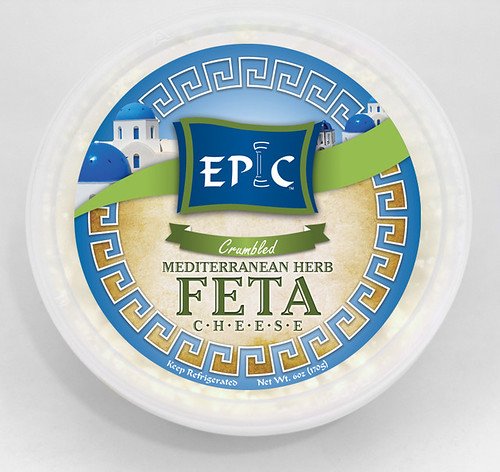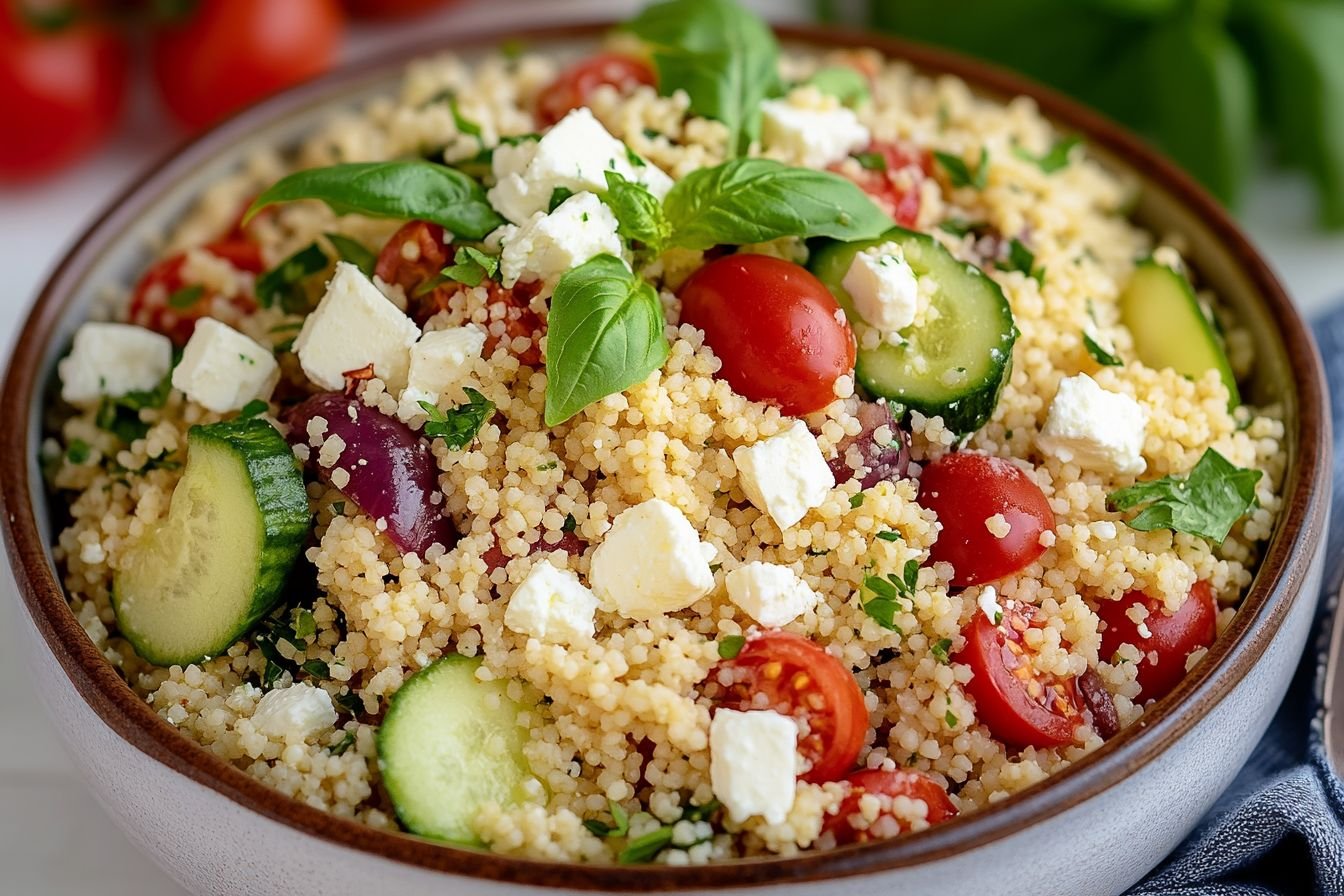Couscous with feta cheese is a delightful dish combining various flavors and textures. To create this tasty meal, you’ll need couscous, vegetable bouillon, extra virgin olive oil, red onion, cucumber, courgette, cherry tomatoes, kalamata olives, feta cheese, basil, flat-leaf parsley, mint, lemon juice, garlic, black pepper, and sea salt. This blend not only tantalizes the taste buds but also offers a refreshing, healthy option for any meal.
The creamy feta complements the fluffy couscous and the vibrant vegetables. It’s an indulgent dish while still being simple to whip up, making it perfect for any occasion, whether a quick dinner or a potluck gathering.
What Is Couscous?
Couscous is a fantastic staple food that originates from North Africa. It consists of tiny granules made from durum wheat semolina. These granules have a light, fluffy texture once cooked, making couscous versatile for various dishes.
I appreciate how easy it is to prepare. It often cooks in just a few minutes. I usually add hot water or broth, cover it, and let it steam.
Couscous pairs well with different ingredients, allowing for creativity in the kitchen. I love adding spices, herbs, or even feta cheese for extra flavor. It’s a wonderful addition to any meal.

Ingredients:
- 1½ cups of dry couscous
- 1⅓ cups of boiled water
- Half a vegetable stock cube
- ¼ cup of extra virgin olive oil
- ½ finely chopped small red onion
- ¼ roughly chopped cucumber
- 1 chopped small zucchini
- 200 g quartered cherry tomatoes
- 10 pitted and halved kalamata olives
- 100 g of cubed feta cheese
- 2 heaped tbsp of chopped basil leaves
- 1 tbsp of chopped flat-leaf parsley
- 1 heaped tsp of chopped mint leaves
- 1 large lemon, juiced
- 2 cloves of minced garlic
- ¼ tsp of cracked black pepper
- ¼ tsp of sea salt
How to make couscous with feta cheese?
- Prepare the stock and add the couscous to a large bowl.
- Gently stir in the stock and cover the bowl with cling film.
- Let the couscous sit for 10 minutes to absorb the liquid.
- Fluff the couscous with a fork and let it cool.
- Add chopped herbs and a splash of lemon juice, stirring well.
- Chop your favorite vegetables and toss them into the couscous.
- Crumble feta cheese over the top, add some olives, drizzle with extra virgin olive oil, and sprinkle in salt and pepper.
- Mix everything until well combined.
- Transfer the couscous to a large serving bowl and enjoy!
Serving Suggestions
Presentation Tips
For a visually appealing dish, I often serve couscous in a wide, shallow bowl. This allows the fluffy grains to spread out, showcasing the feta crumbles and any additional ingredients.
I like to sprinkle chopped fresh herbs, such as parsley or mint, on top for a pop of color. You can also add some cherry tomatoes or diced cucumbers for extra freshness.
Consider using lemon wedges as a garnish, inviting guests to squeeze some juice over their servings. This brightens the dish nicely and adds a zesty finish.
Accompaniments and Pairings
This couscous salad pairs beautifully with a variety of dishes. I often enjoy it alongside grilled vegetables like zucchini, bell peppers, or eggplant. These add a smoky flavor that complements the creamy feta.
Another great option is to pair it with a protein, such as grilled chicken or lamb. The savory notes from the meat create a satisfying meal.
For a lighter accompaniment, a simple mixed green salad dressed with olive oil and lemon enhances the flavors. It keeps the meal fresh and balanced.
Lastly, serving pita bread or crispy flatbreads on the side offers a nice texture contrast. Guests can scoop up the couscous or enjoy a bite alongside it.
Storing and Reheating
Refrigeration Guidelines
To store leftovers, I transfer them to an airtight container. This prevents moisture loss and keeps the dish fresh. I usually refrigerate it within two hours of cooking to limit bacterial growth.
My refrigerator’s temperature should be set at or below 40°F (4°C). The couscous can last for about 3 to 4 days in the fridge. If I notice any off smells or changes in texture, I discard the salad to avoid any risk.
For longer storage, I freeze my couscous. It keeps well for up to 2 months. When freezing, I portion it into meal-sized servings, which makes defrosting easier later.
Best Practices for Reheating
When I’m ready to enjoy my couscous again, I consider my reheating options. I often use the microwave as it’s quick and convenient. To do so, I place the couscous in a microwave-safe dish, add a splash of water to keep it moist, and cover it with a lid or microwave-safe wrap.
I heat it in 1-minute intervals, stirring in between, until it reaches my desired temperature. This method helps to evenly warm the dish without drying it out.
If I prefer using the stovetop, I add a little olive oil or water in a skillet over medium heat. This takes a bit longer, but it revives the flavors beautifully. I stir frequently and remove it from heat once it’s warmed through.
Tips and Tricks
- Choose the Right Couscous: I usually prefer using Israeli or pearl couscous for a hearty texture. Regular couscous works too, but it tends to be lighter.
- Flavor the Liquid: When cooking couscous, I often replace water with vegetable or chicken broth. This adds an extra layer of flavor.
- Don’t Skimp on Ingredients: Fresh herbs elevate the dish. I love adding chopped parsley or mint for a burst of freshness.
- Add Vegetables: Roasted bell peppers, zucchini, or cherry tomatoes improve the taste and nutrition. I mix them in just before serving.
- Mix Feta Wisely: I crumble the feta cheese instead of mixing it directly into the hot couscous. This keeps the texture intact and creates a lovely creaminess.
- Let It Rest: After cooking, I let the couscous sit covered for about 5 minutes. This step helps absorb flavors better.
- Experiment with Dressings: A simple lemon vinaigrette uplifts the dish. I mix olive oil, lemon juice, salt, and pepper for a quick dressing.
Conclusion
Couscous with feta cheese combines delightful flavors and textures. I appreciate how it is versatile in meals, whether as a side dish or a main course.
The lightness of couscous pairs beautifully with the richness of feta, adding a unique twist to my meals. I often toss in fresh vegetables for color and nutrition.
Couscous with feta cheese not only satisfies my hunger but also excites my palate. Its simplicity allows me to enjoy a delicious meal without spending hours in the kitchen.
As already mentioned, crusty Lebanese bread is a delicious pairing for this dish.
Get that recipe now (by clicking the image below):





